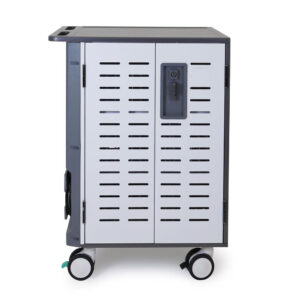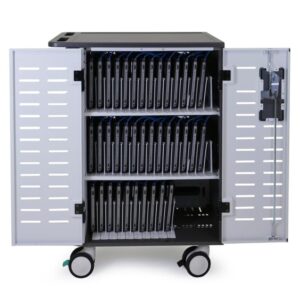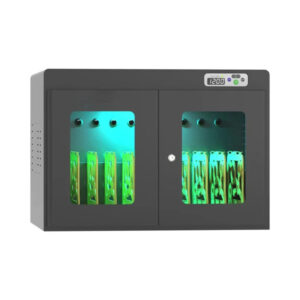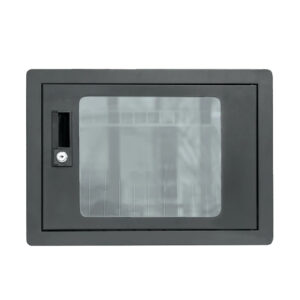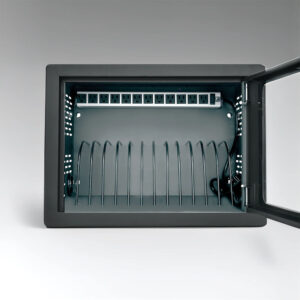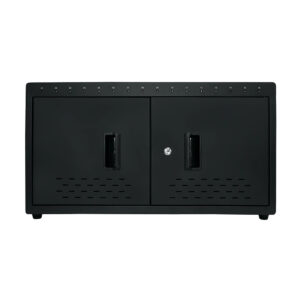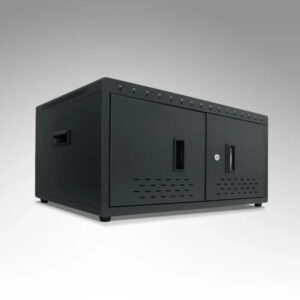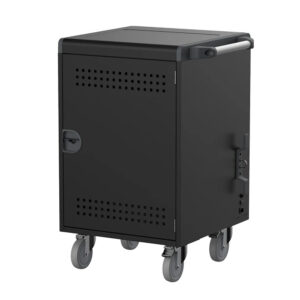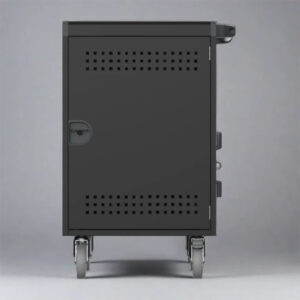Summary
Protect Your Fleet: How Secure Charging Cabinets Reduce Device Loss and Damage is an essential overview of secure charging cabinets, which have become critical in managing mobile device fleets in various sectors, particularly in education and corporate environments. As organizations increasingly rely on mobile technology for their operations, the challenges associated with device management, including tracking, security, and charging, have become prominent issues. The adoption of secure charging cabinets addresses these challenges by providing a centralized solution that not only safeguards devices but also ensures they remain charged and ready for use, thus enhancing operational efficiency and reducing costs associated with lost or damaged equipment.
The significance of secure charging cabinets is underscored by the rise of device loss and the phenomenon of “ghosted” devices—those that are lost or unaccounted for—resulting in substantial financial losses for many businesses. Companies such as Zebra Technologies offer innovative products that tackle these complexities, incorporating advanced security features and smart charging capabilities that cater to a range of devices. These cabinets, equipped with locking mechanisms and organizational designs, help mitigate the risks of theft and misplacement, fostering a culture of responsibility among users.
Moreover, the environmental impact of electronic waste and sustainability concerns are driving the need for such solutions. By extending the lifespan of devices and minimizing the need for replacements, secure charging cabinets contribute to sustainability efforts within organizations. However, the implementation of these systems does come with challenges, including initial investment costs and the necessity for ongoing maintenance, which organizations must navigate to maximize their benefits.
In summary, secure charging cabinets represent a pivotal advancement in the management of mobile technology assets, addressing security, organization, and sustainability challenges in an increasingly digital landscape. Their adoption is not only reshaping device management practices but also enhancing productivity across various sectors by ensuring devices are always ready for use, ultimately reducing operational risks and costs associated with device loss and damage.
Table of Contents
Background
In today’s digital landscape, businesses increasingly rely on mobile devices for daily operations. However, managing a growing fleet of mobile computers and tablet PCs presents several challenges, including device tracking, security, and ensuring that devices are adequately charged. The absence of a centralized management system often leads to operational inefficiencies and increased costs associated with downtime and lost or misplaced devices.
To address these challenges, secure charging cabinets have emerged as a practical solution for enterprises. These cabinets not only provide a safe storage environment for devices but also integrate charging capabilities, which are essential for maintaining device readiness. For instance, Zebra Technologies offers an Intelligent Cabinets product line designed specifically to tackle the complexities of managing mobile device fleets, ensuring that devices are returned for charging at the end of shifts while also enhancing security and accountability.
Moreover, outdoor fiber cabinets, which protect critical telecommunications infrastructure, highlight the importance of safeguarding technology assets. These cabinets are designed to withstand vandalism and electrical hazards, including lightning strikes, through advanced protective features such as grounding systems and coatings that facilitate graffiti removal. The combination of secure storage and effective monitoring systems ensures not only the longevity of the devices but also minimizes operational risks that could disrupt business continuity.
The rise of ghosted devices—those that are lost or unaccounted for—further exacerbates the issue, with studies indicating significant losses annually for many organizations. By implementing secure charging cabinets, businesses can significantly reduce these risks, thereby enhancing productivity and operational efficiency in an increasingly mobile and digital work environment.
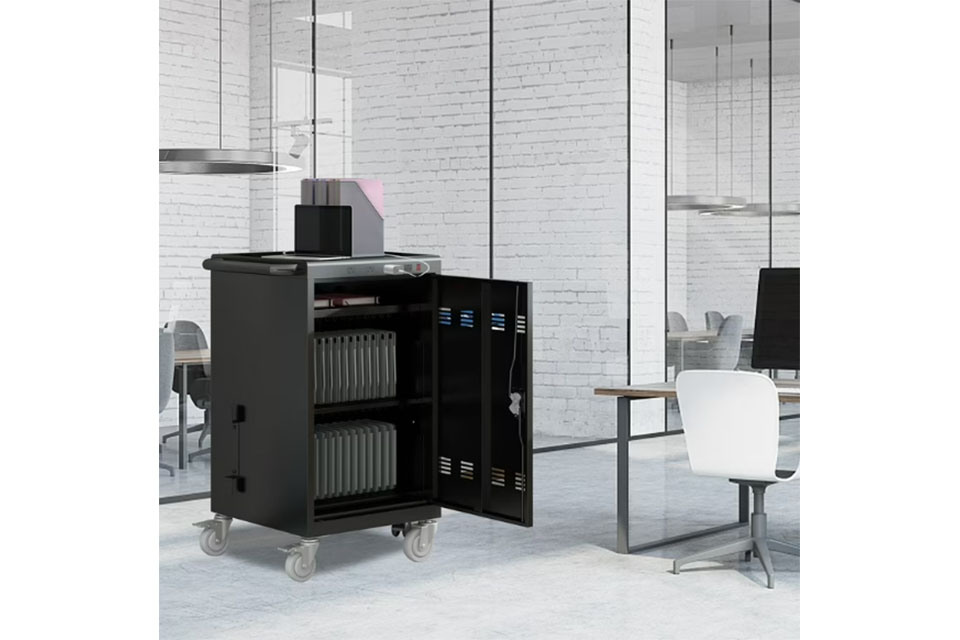
Secure Charging Cabinets
Secure charging cabinets provide an essential solution for safeguarding devices while simultaneously ensuring efficient charging processes. These cabinets are designed to accommodate multiple devices, allowing for the simultaneous charging of laptops, tablets, and other electronic equipment in a secure and organized manner.
Features and Benefits
Security Features
The primary advantage of secure charging cabinets is their enhanced security features. Many models come equipped with advanced locking mechanisms, such as key locks, digital codes, and RFID systems, which protect devices from theft and unauthorized access. Users frequently praise the robust construction and effective locking systems, which provide peace of mind for IT administrators in educational and corporate environments alike.
Smart Charging Capabilities
In addition to security, these cabinets often include smart charging capabilities that optimize charging times. This ensures that devices are charged efficiently, reducing energy costs and minimizing wait times for users.
Capacity and Flexibility
Secure charging cabinets are available in various sizes and configurations, catering to different institutional needs. They can hold a limited number of devices or accommodate larger systems capable of managing many units, making them versatile for any environment. Furthermore, they can be integrated with access control systems, allowing administrators to manage who can use specific devices and when, thereby enhancing the overall security and accountability of the assets.
Total Cost of Ownership
When considering the acquisition of secure charging cabinets, it is crucial to evaluate the total cost of ownership. This includes not only the initial purchase price but also potential maintenance and repair costs over time. Many clients have reported that these products maintain their organization and durability, reinforcing their reputation for quality and longevity. By investing in high-quality charging solutions, institutions can reduce overall expenses while ensuring the safety and efficiency of their technology assets.
Benefits of Secure Charging Cabinets
Secure charging cabinets offer numerous advantages that enhance the management and security of devices across various sectors, including education, corporate environments, and public spaces.
Ensuring Device Readiness
One of the primary benefits of secure charging cabinets is their ability to ensure that devices are always charged and ready for use. By providing a centralized storage solution, these cabinets allow for efficient device management, making it easy for students and educators to access fully charged devices when needed. This eliminates the common issue of last-minute charging, promoting a seamless integration of technology into the classroom and enhancing digital learning experiences.
Security and Organization
Charging cabinets significantly enhance security by reducing the risk of device loss or theft. With all devices stored in a secure location, organizations can minimize replacements due to missing items. Many charging cabinets feature lockable doors and robust construction to protect valuable technology investments from unauthorized access and damage. This organized approach also helps streamline equipment management, reducing interruptions and fostering a culture of responsibility among users regarding technology usage.
Supporting Digital Learning
In educational settings, secure charging cabinets support digital learning by ensuring that devices are readily available and operational. This is crucial in environments where technology plays a central role in the curriculum. Moreover, the organized layout of charging stations aids in maintaining order and accountability among students.
Environmental Sustainability
By extending the lifespan of devices through effective management, charging cabinets contribute to sustainability efforts by reducing the need for new device production. This helps lower the carbon footprint associated with manufacturing new devices and minimizes electronic waste, thereby supporting organizational sustainability goals.
Improved Productivity in Corporate Settings
In corporate environments, secure charging cabinets facilitate better management of personal devices, thereby improving employee productivity. With devices always charged and ready for use, employees can focus on their tasks without the distraction of searching for malfunctioning equipment or low-battery devices. Companies that have implemented such solutions have reported significant increases in operational efficiency and overall productivity.
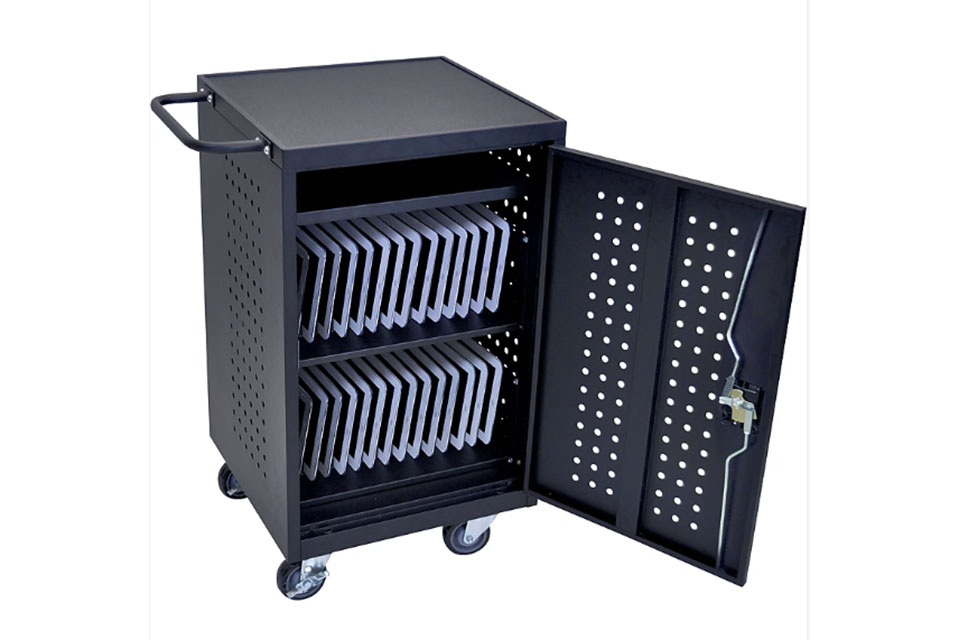
Implementation
Overview of Charging Cabinet Integration
The implementation of charging cabinets within organizations requires careful planning and execution to ensure effective device management and security. These cabinets, also referred to as charging stations or charging carts, are designed to efficiently manage and charge multiple electronic devices simultaneously, enhancing usability across various settings such as educational institutions and corporate offices. Organizations must evaluate their specific needs and determine the best placement and configuration for these units.
Design and Capacity Considerations
When integrating charging cabinets, it is essential to select designs that accommodate a variety of devices, including tablets, laptops, and smartphones. Typically featuring built-in power outlets and USB ports, these cabinets enable simultaneous charging while incorporating adjustable shelves or compartments to organize devices neatly. This design promotes ease of access, reducing clutter and enhancing the user experience. For optimal functionality, organizations should consider the anticipated number of devices and the layout of the space in which the charging cabinets will be installed.
Advanced Charging Technology
To streamline the charging process, organizations can utilize advanced charging technology embedded in modern charging cabinets. Many units come equipped with features that simplify usage for both students and staff, such as intuitive layouts and effective cable management solutions. The implementation of real-time monitoring systems that provide updates on charging status further enhances the ability to manage devices effectively, ensuring that all units are always ready for use.
Addressing Implementation Challenges
While charging cabinets offer numerous advantages, organizations may face challenges related to initial investment costs, ongoing maintenance, and compliance with safety regulations. A strategic approach to overcoming these hurdles involves assessing budgetary constraints and planning for long-term maintenance to maximize the utility of charging solutions. Moreover, organizations must ensure user engagement and adaptability to rapidly evolving technological demands, which may require periodic upgrades or adjustments to the existing charging infrastructure.
Employee Training and Support
Successful implementation of charging cabinets also hinges on comprehensive employee training. Staff must be familiarized with the functionalities and benefits of the cabinets to fully leverage their capabilities. Organizations should provide clear instructions and support, ensuring that all users understand how to access and utilize the cabinets efficiently. Continuous feedback mechanisms can help identify areas for improvement and enhance user satisfaction.
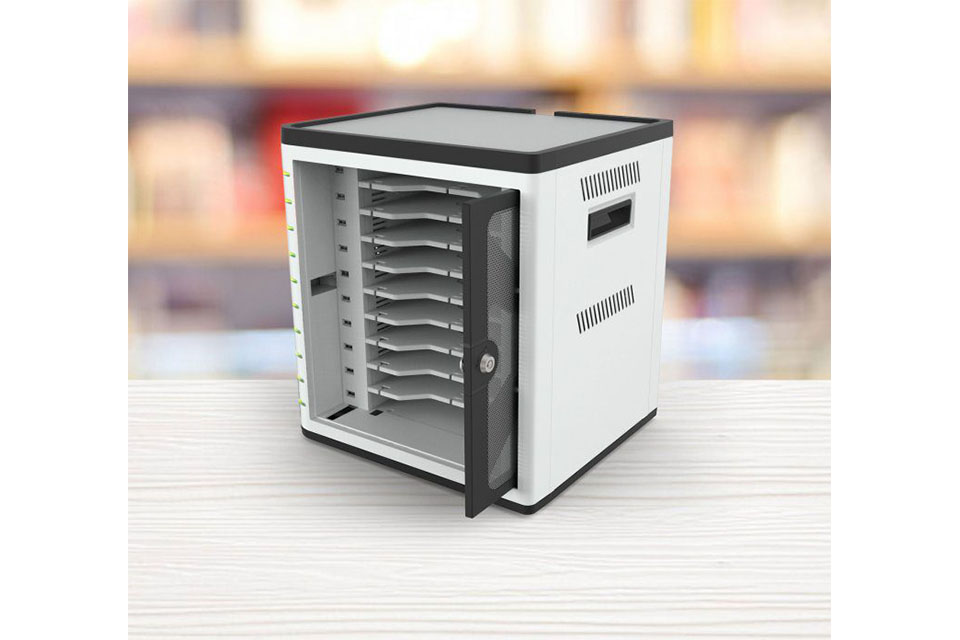
Case Studies
Equifax Data Breach
The Equifax data breach serves as a prominent example of the severe implications of human error in data security. The breach resulted from expired certificates and misconfigured devices, leading to unauthorized access to sensitive information. This incident not only caused significant financial losses for the company but also severely damaged its reputation, underscoring the critical need for robust cybersecurity measures that address human error as a major risk factor in data breaches.
Ericsson Data Breach
Another notable case is the Ericsson data breach, which was similarly attributed to certificate expiration. This incident highlighted vulnerabilities in security protocols that, when overlooked, could lead to unauthorized access to sensitive data. The fallout from such breaches illustrates the importance of maintaining up-to-date security measures and regular audits to prevent similar occurrences in the future.
LinkedIn Data Breach
The LinkedIn data breach exemplifies how misconfiguration errors can lead to compromised user data. This breach emphasizes the necessity for organizations to invest in comprehensive training for staff to minimize human errors that can compromise data integrity. Effective communication and timely updates about security practices are essential in preventing such lapses.
Data Recovery Solutions
In light of these breaches, the importance of data recovery solutions has become increasingly evident. For instance, advanced tools like Cellebrite UFED Ultimate have proven effective in retrieving lost data due to accidental deletions or physical damage to storage devices. Organizations must implement a robust data backup strategy that includes redundant storage and regular testing of restoration processes to mitigate the risks associated with data loss.
Importance of Multiple Backups
The impact of having multiple data backups cannot be overstated. The real-life case studies demonstrate that comprehensive backup strategies are essential for businesses to safeguard against data loss. For instance, organizations that invest in reliable data recovery tools and maintain multiple backup systems have a greater chance of successfully retrieving crucial information, thereby ensuring continuity of operations.
Challenges and Considerations
Security Features
The importance of security features in charging cabinets cannot be overstated. Users consistently emphasize the need for effective locking mechanisms and robust construction to ensure that valuable devices are protected against theft and damage. As highlighted by a Network Manager, “The device has proved a hit with both the pupils and staff and will be a permanent fixture in the classroom for many years to come!”. This sentiment underscores the necessity of having reliable security measures in place, especially in educational settings where devices are frequently used and accessed by multiple users.
Customer Support
Customer support plays a crucial role in user satisfaction when it comes to charging solutions. Brands that provide responsive and helpful customer service tend to receive higher ratings from users, particularly during installation and troubleshooting. Alex M., a Senior Systems Analyst, expressed appreciation for the support received during the Go2 Case installation, stating, “Thank you for the Go2 Case! You nailed it again!”. This reflects the critical nature of having accessible and effective customer service, as it can significantly enhance the overall user experience.

Future Growth Considerations
As technology continues to evolve, educational institutions must consider future growth when selecting charging solutions. It is essential to choose cabinets that can accommodate potential future needs, such as the addition of more devices or enhanced security features. D. Wilson, an IT Technician, noted, “Lyte from LapCabby has been the perfect way for us to protect our investment across the school!”. This proactive approach can help institutions adapt to the increasing integration of technology in education.
Total Cost of Ownership
When evaluating the overall budget for a charging solution, organizations should factor in the total cost of ownership, which includes maintenance and potential repair costs. Users have reported that high-quality products maintain their organization and durability over time, reinforcing their reputation for quality. Dana Tucker observed that the company’s products keep items orderly, providing practical confirmation of their efficiency. Understanding the total cost of ownership can offer a clearer picture of the financial commitment involved.
Ease of Use and Reliability
Ease of use is another critical factor for educational environments, where time efficiency is paramount. Users appreciate storage units that are intuitive and straightforward to operate, enabling quick access to equipment. A Director of Technology remarked, “Our first impressions were good; we liked how it looked, so we tried it, we loved it, and two years later we haven’t looked back!”. Furthermore, reliability is emphasized in many reviews, as the durability of the cabinet and the reliability of the charging process are essential, especially in high-traffic settings. A Senior Desktop Support Specialist stated, “The DeskCabby keeps our equipment and cables safe and secure. It’s the best product we’ve had!”.
User Feedback
Reading customer reviews provides valuable insights into the performance and reliability of charging cabinets in real-world settings. Feedback regarding ease of use, security features, and overall satisfaction can guide potential buyers in their decision-making process. Testimonials like those from G. Roberts, a Network Manager, who noted the popularity of the device among students and staff, further emphasize its effectiveness in educational environments. Such insights are crucial for organizations seeking dependable power and storage systems to protect their valuable devices.
Future Trends
In the rapidly evolving landscape of workplace environments, the demand for flexible and adaptable solutions is increasing. This transformation is propelled by advancements in technology and a growing recognition of the limitations of traditional office layouts. As businesses adapt to these changes, the integration of secure charging cabinets has emerged as a key trend to enhance employee efficiency and satisfaction, while addressing the challenges posed by a diverse range of devices used in corporate settings.
Enhanced Asset Management
Future innovations in charging cabinets will focus on enhanced asset management capabilities. Centralized dashboards are expected to provide organization-wide oversight, allowing for better tracking and reporting of device usage and charging status. This approach aims to streamline operations and improve the overall efficiency of device management within the workplace.
Sustainability and Integration
Sustainability remains a critical consideration for organizations looking to modernize their infrastructure. Charging solutions that incorporate energy-efficient technologies, such as smart USB-C ports and load-balancing circuitry, are anticipated to become more prevalent, optimizing charging times and reducing energy costs. Furthermore, seamless integration with existing organizational software will enable companies to adapt quickly to technological advancements and maintain the effectiveness of their charging infrastructure.
Multi-Device Hubs
The future of charging cabinets will likely include multi-device hubs that accommodate various types of equipment, such as laptops, tablets, VR headsets, and drones, within a single unit. This innovation aims to support the increasing complexity of modern workplaces, where diverse devices must be managed efficiently. By consolidating charging solutions, organizations can reduce clutter, enhance organization, and create a more productive work environment.
Addressing Challenges
As organizations implement these advanced charging solutions, they will need to remain vigilant about the rapid pace of technological advancement. Keeping up with updates in charging technology and software improvements is essential to avoid inefficient charging practices or diminished performance of the cabinets. By proactively addressing these challenges, businesses can ensure that their investments in charging infrastructure yield maximum benefits.
Broader Adoption in Public Spaces
The popularity of charging cabinets is expected to extend beyond traditional office environments, finding applications in public spaces such as malls, airports, and libraries. This shift underscores the growing societal demand for convenient and reliable charging solutions in various settings, reflecting the increasing integration of technology into everyday life. As these trends continue to evolve, organizations must be prepared to adapt their strategies to accommodate changing user needs and preferences.



